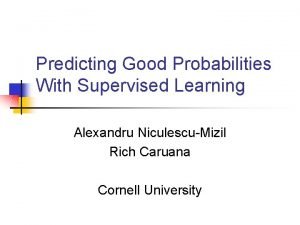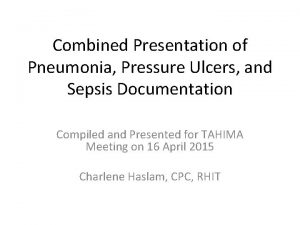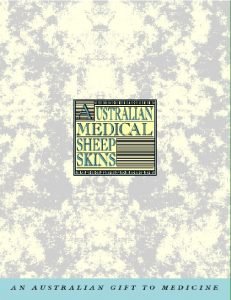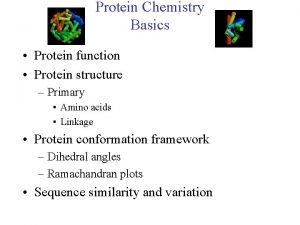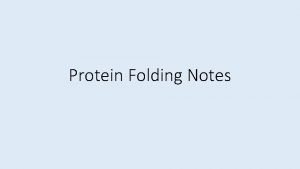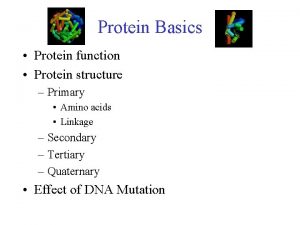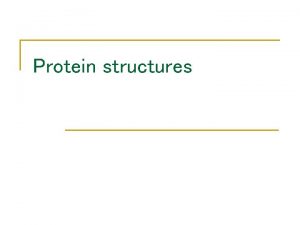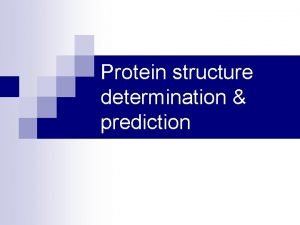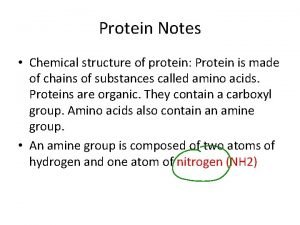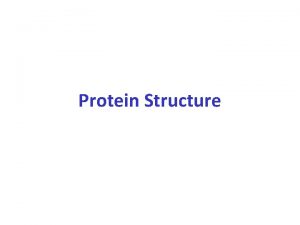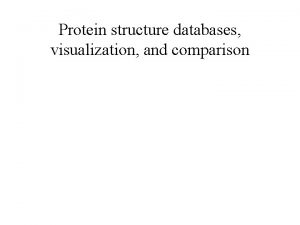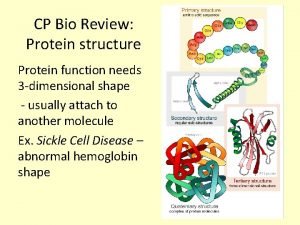Predicting protein structure and function Protein function GenomeDNA















- Slides: 15

Predicting protein structure and function

Protein function Genome/DNA Transcription factors Transcriptome/m. RNA Proteome Ribosomal proteins Chaperonins Metabolome Enzymes Physiome

Protein function Not all proteins are enzymes: -crystallin: eye lens protein – needs to stay stable and transparent for a lifetime (very little turnover in the eye lens)

What can happen to protein function through evolution Proteins can have multiple functions (and sometimes many -- Ig). Enzyme function is defined by specificity and activity Through evolution: • Function and specificity can stay the same • Function stays same but specificity changes • Change to some similar function (e. g. somewhere else in metabolic system) • Change to completely new function

How to arrive at a given function • Divergent evolution – homologous proteins –proteins have same structure and “sameish” function • Convergent evolution – analogous proteins – different structure but same function • Question: can homologous proteins change structure (and function)?

How to evolve Important distinction: • Orthologues: homologous proteins in different species (all deriving from same ancestor) • Paralogues: homologous proteins in same species (internal gene duplication) • In practice: to recognise orthology, bi-directional best hit is used in conjunction with database search program

How to evolve By addition of domains (at either end of protein sequence) – Lesk book page 108 Often through gene duplication followed by divergence

Structural domain organisation can be nasty… Pyruvate kinase Phosphotransferase barrel regulatory domain / barrel catalytic substrate binding domain / nucleotide binding domain 1 continuous + 2 discontinuous domains

The DEATH Domain http: //www. mshri. on. ca/pawson • Present in a variety of Eukaryotic proteins involved with cell death. • Six helices enclose a tightly packed hydrophobic core. • Some DEATH domains form homotypic and heterotypic dimers.

How to predict function • Sequence information: Homology searching • Sequence-structure information: Fold recognition (Threading) • Structure-structure information: structure superpositioning

Flavodoxin fold

Rules of thumb when looking at a multiple alignment (MA) • • Hydrophobic residues are internal Gly (Thr, Ser) in loops MA: hydrophobic block -> internal -strand MA: alternating (1 -1) hydrophobic/hydrophilic => edge -strand • MA: alternating 2 -2 (or 3 -1) periodicity => -helix • MA: gaps in loops • MA: Conserved column => functional? => active site

Rules of thumb when looking at a multiple alignment (MA) • Active site residues are together in 3 D structure • Helices often cover up core of strands • Helices less extended than strands => more residues to cross protein • - - motif is right-handed in >95% of cases (with parallel strands) • MA: ‘inconsistent’ alignment columns and match errors! • Secondary structures have local anomalies, e. g. -bulges

Burried and Edge strands Parallel -sheet Anti-parallel -sheet

Periodicity patterns Burried -strand Edge -strand -helix
 Makalah previewing and predicting
Makalah previewing and predicting The aim of previewing is
The aim of previewing is The evolution of crm is reporting analyzing and predicting
The evolution of crm is reporting analyzing and predicting Di vs bis
Di vs bis Channel vs carrier proteins
Channel vs carrier proteins Protein-protein docking
Protein-protein docking Predicting products of chemical reactions
Predicting products of chemical reactions Predicting products of chemical reactions
Predicting products of chemical reactions Chemistry predicting products
Chemistry predicting products Predicting good probabilities with supervised learning
Predicting good probabilities with supervised learning Section 3 predicting the products of chemical reactions
Section 3 predicting the products of chemical reactions Highest braden score
Highest braden score Braden scale for predicting pressure sore risk
Braden scale for predicting pressure sore risk Prediction pip
Prediction pip Predicting pip
Predicting pip Pg 91
Pg 91









